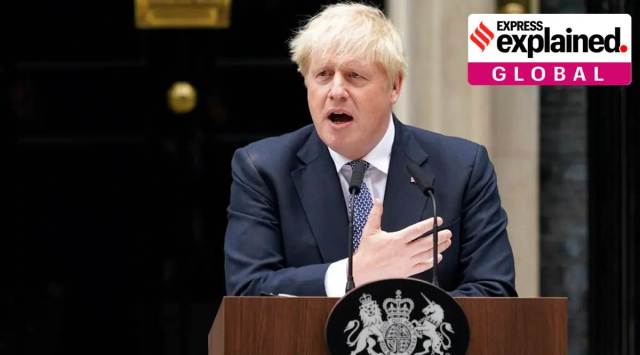Explained: What is the 1922 Committee, how will it decide Britain’s next PM?
The Committee will also decide whether or not they want outgoing PM Boris Johnson to remain in power until the new Tory leader steps in.
 British Prime Minister Boris Johnson speaks to media next to 10 Downing Street in London. (AP)
British Prime Minister Boris Johnson speaks to media next to 10 Downing Street in London. (AP)The 1922 Committee, an influential group of Conservative backbench ministers in the UK, will hold its executive elections on Monday (July 11), after which it will establish the rules and the timetable to pick a Tory leader who will be Britain’s next prime minister.
The Committee will also decide whether or not they want outgoing PM Boris Johnson to remain in power until the new Tory leader steps in.
Johnson had said in his resignation speech on July 7, that he would continue to be PM until a new Tory leader gets elected.
However, former PM Sir John Major has urged the 1992 Committee to immediately remove Johnson from his post and install a new caretaker PM, as it would be “unwise and may be unsustainable” for him to remain in power.
What is the 1922 Committee?
The 1922 Committee, formally known as the Conservative Private Members’ Committee, is a group of all Conservative backbench MPs who do not hold any government or opposition posts.
They conduct weekly meetings when Parliament is in session and discuss matters pertaining to the party. They are an influential group who have the power to organise leadership challenges to their own Prime Minister and also play an important role in selecting the next party leader.
The Committee provides a platform to less senior MPs to discuss matters relevant to the party and convey their opinion to ministers in their own government. The Sun reports that since 2010, frontbenchers, i.e government ministers, that are allocated portfolios or opposition shadow spokespersons, have also been allowed to attend Committee meetings.
Why is it called the 1922 Committee?
The 1922 Committee is mistakenly thought to have got its name from the famous October 1922 meeting of Conservative Party members at the Carlton Club, where Tory leaders demanded their withdrawal from the ruling coalition government of 1916-1922, and successfully brought it down.
The group, however, was actually established in April 1923 when new Tory MPs, who were elected in the 1922 general election, sought to develop a forum to enable cooperation within the party and aid in the integration of new members.
How is a leadership challenge mounted?
The 1922 Committee is led by an 18-member executive committee, whose elected chair supervises the election of party leaders, or the vote of no-confidence against their own prime minister.
The current chair is Graham Brady, who was appointed in 2010 and issued leadership challenges to the prime ministers Theresa May and Boris Johnson.
According to Conservative Party’s rules, a leadership challenge can be introduced if 15% of the Tory members of parliament (MPs) write letters to the chair of the party’s 1922 Committee, stating their desire for a no-confidence vote.
Only the Committee knows the number of letters that were sent and who wrote them.
To survive the motion and to remain in power, a sitting prime minister needs the support of at least half the party’s members of parliament.
Before his long demanded exit, Boris Johnson had survived a 1922 Committee initiated no-confidence motion against him on June 6.
His predecessor, Theresa May also faced a no-confidence motion by the Conservative Party in 2018, after members opposed her compromised Brexit deal. Despite winning 200 votes to 117, the rebellion left her reputation beyond repair and she was forced to resign six months later.
May had in fact performed better than Johnson in the no-confidence vote, with only 37% voting against her to the 41% that opposed Johnson.
How will Britain’s next PM be decided?
To take part in the prime ministerial race, a Conservative MP requires a nomination by at least 8 other Tory MPs. A report in the Independent said that the Committee might re-look at this threshold of support.
In the next phase, if more than two MPs are able to secure enough nominations, a series of secret ballots will be held with party MPs voting to reduce the number of candidates. This goes on until only two candidates remain in the contest.
The next phase kicks in after that. During this drill, grassroots party members decide between the two remaining MPs before a deadline set by the 1922 Committee. The winner of this round goes on to become the leader of the Conservative Party, and, in the present scenario, the PM.
It is unclear how long this will take. When Johnson replaced May in 2019, the entire leadership process took around 6 weeks, as reported by The Guardian.
In his letter to the chair of the 1922 Committee, former PM Major has recommended that after Johnson is removed, deputy Prime Minister Dominic Raab should be the interim PM until another Tory leader is decided to take over. However, the Guardian reports that this has no constitutional precedent. Major stated that the other possibility to hasten Johnson’s removal would be to eliminate the vote of party members and allow only MPs to decide the future prime minister.
While Johnson wants to remain in power as interim PM until his successor steps in, the New York Times reports that “the timetable for the leadership contest is not in his hands, and it does not follow a published set of rules”.
However, it is expected that the new prime minister will be in office by September 5, when the House of Commons returns from its summer break.
- 01
- 02
- 03
- 04
- 05






































